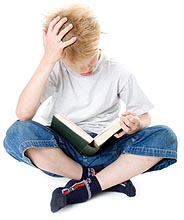Visual Discrimination Difficulties

The learning disabled who have difficulties in visual discrimination are unable to recognize similarities and differences between letters and words. They especially find difficulty making differentiation between similar-looking letters such as /n/, /m/, /u / or /b/, /d/, /p/, /q/, etc., or between words such as /hat/, /hot/, /hate/ or /pug/, /bug/, or /no/, /on/, etc. Recognizing letters requires the ability to make rather fine discriminations which, in turn, is dependent on the ability to make gross visual discriminations. If larger forms like geometric shapes cannot be differentiated, then the subtleties of letters would elude the learning disabled. Three of the more common forms of discrimination problems to be noted in the learning disabled include reversals, rotations, and inversions.
- Reversals — The most common type of problem cited to exemplify reversals is the confusion between /b/ and /d/. This confusion represents the exact mirror-imaging that some learning disabled experience. When words containing /b/ or /d/ are read, they are frequently misread because they have been perceived oppositely, as, for example, /bad/ for /dab/, /big/ for /dig/, etc., or vice versa.
- Rotations — The form of the letter is rotated so that it is perceived differently; for example, the letter /b/ may be read as /p/ because the child has rotated the axis from its original upward direction to a downward direction, or confusing /b/ for /q/ which would be a rotation of a greater magnitude, with the axis seen as going down the opposite side.
- Inversions — A variation of both reversal and rotation is an inversion. The letter form is inverted. Thus, the child may confuse /n/ with /u/ and /m/ with /w/, etc.
< Previous Page | Next Page >
|
